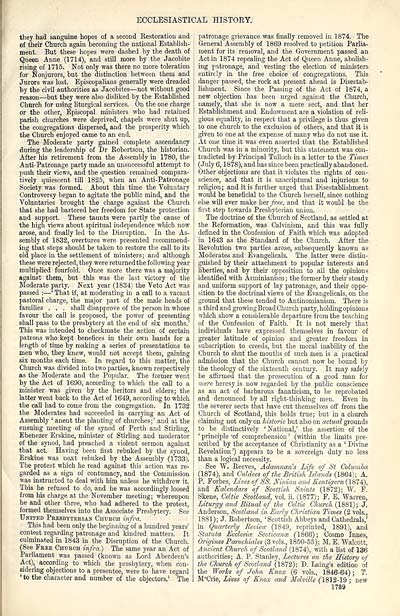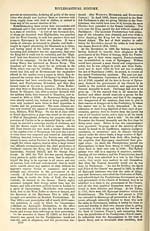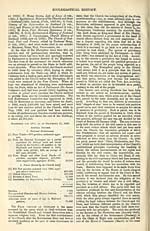Ordnance gazetteer of Scotland
(1747) Page 1739
Download files
Complete book:
Individual page:
Thumbnail gallery: Grid view | List view

ECCLESIASTICAL HISTORY.
they had sanguine hopes of a second Restoration and
of their Church again becoming the national Establish-
ment. But these hopes were dashed by the death of
Queen Anne (1714), and still more by the Jacobite
rising of 1715. Not only was there no more toleration
for Nonjurors, but the distinction between them and
Jurors was lost. Episcopalians generally were dreaded
by the civil authorities as Jacobites — not without good
reason — but they were also disliked by the Established
Church for using liturgical services. On the one charge
or the other, Episcopal ministers who had retained
parish churches were deprived, chapels were shut up,
the congregations dispersed, and the prosperity which
the Church enjoyed came to an end.
The Moderate party gained complete ascendancy
during the leadership of Dr Robertson, the historian.
After his retirement from the Assembly in 1780, the
Anti- Patronage party made an unsuccessful attempt to
push their views, and the question remained compara-
tively quiescent till 1825, when an Anti-Patronage
Society was formed. About this time the Voluntary
Controversy began to agitate the public mind, and the
Voluntaries brought the charge against the Church
that she had bartered her freedom for State protection
and support. These taunts were partly the cause of
the high views about spiritual independence which now
arose, and finally led to the Disruption. In the As-
sembly of 1832, overtures were presented recommend-
ing that steps should be taken to restore the call to its
old place in the settlement of ministers; and although
these were rejected, they were returned the following year
multiplied fourfold. Once more there was a majority
against them, but this was the last victory of the
Moderate party. Next year (1834) the Veto Act was
passed : — ' That if, at moderating in a call to a vacant
pastoral charge, the major part of the male heads of
families . . . shall disapprove of the person in whose
favour the call is proposed, the power of presenting
shall pass to the presbytery at the end of six months.'
This was intended to checkmate the action of certain
patrons who kept benefices in their own hands for a
length of time by making a series of presentations to
men who, they knew, would not accept them, gaining
six months each time. In regard to this matter, the
Church was divided into two parties, known respectively
as the Moderate and the Popular. The former went
by the Act of 1690, according to which the call to a
minister was given by the heritors and elders; the
latter went back to the Act of 1649, according to which
the call had to come from the congregation. In 1732
the Moderates had succeeded in carrying an Act of
Assembly ' anent the planting of churches;' and at the
ensuing meeting of the synod of Perth and Stirling,
Ebenezer Erskine, minister of Stirling and moderator
of the synod, had preached a violent sermon against
that act. Having been first rebuked by the synod,
Erskine was next rebuked by the Assembly (1733).
The protest which he read against this action was re-
garded as a sign of contumacy, and the Commission
was instructed to deal with him unless he withdrew it.
This he refused to do, and he was accordingly loosed
from his charge at the November meeting; whereupon
he and other three, who had adhered to the protest,
formed themselves into the Associate Presbytery. See
United Presbyterian Church infra.
This had been only the beginning of a hundred years'
contest regarding patronage and kindred matters. It
culminated in 1843 in the Disruption of the Church.
(See Free Church infra.) The same year an Act of
Parliament was passed (known as Lord Aberdeen's
Aet),_ according to which the presbytery, when con-
sidering objections to a presentee, were to have regard
'■ to the character and number of the objectors.' The
patronage grievance was finally removed in 1874. The
General Assembly of 1869 resolved to petition Parlia-
ment for its removal, and the Government passed an
Act in 1874 repealing the Act of Queen Anne, abolish-
ing patronage, and vesting the election of ministers
entirely in the free choice of congregations. This
danger passed, the rock at present ahead is Disestab-
lishment. Since the Passing of the Act of 1874, a
new objection has been urged against the Church,
namely, that she is now a mere sect, and that her
Establishment and Endowment are a violation of reli-
gious equality, in respect that a privilege is thus given
to one church to the exclusion of others, and that it is
given to one at the expense of many who do not use it.
At one time it was even asserted that the Established
Church was in a minority, but this statement was con-
tradicted by Principal Tulloch in a letter to the Times
(July 6, 1878), and has since been practically abandoned.
Other objections are that it violates the rights of con-
science, and that it is unscriptural and injurious to
religion; and it is further urged that Disestablishment
would be beneficial to the Church herself, since nothing
else will ever make her free, and that it would be the
first step towards Presbyterian union.
The doctrine of the Church of Scotland, as settled at
the Reformation, was Calvinism, and this was fully
defined in the Confession of Faith which was adopted
in 1643 as the Standard of the Church. After the
Revolution two parties arose, subsequently known as
Moderates and Evangelicals. The latter were distin-
guished by their attachment to popular interests and
liberties, and by their opposition to all the opinions
identified with Arminianism; the former by their steady
and uniform support of lay patronage, and their oppo-
sition to the doctrinal views of the Evangelicals, on the
ground that these tended to Antinomianism. There is
a third and growingBroad Church party, holding opinions
which show a considerable departure from the teaching
of the Confession of Faith. It is not merely that
individuals have expressed themselves in favour of
greater latitude of opinion and greater freedom in
subscription to creeds, but the moral inability of the
Church to shut the mouths of such men is a practical
admission that the Church cannot now be bound by
the theology of the sixteenth century. It may safely
be affirmed that the prosecution of a good man for
mere heresy is now regarded by the public conscience
as an act of barbarous fanaticism, to be reprobated
and denounced by all right-thinking men. Even in
the severer sects that have cut themselves off from the
Church of Scotland, this holds true; but in a church
claiming not only on historic but also on actual grounds
to be distinctively 'National,' the assertion of the
' principle 'of comprehension ' (within the limits pre-
scribed by the acceptance of Christianity as a ' Divine
Revelation') appears to be a sovereign duty no less
than a logical necessity.
See W. Reeves, Adamnan's Life of St Columha
(1874), and Culdees of the British Islands (1864); A.
P. Forbes, Lives of SS. Ninianand Kentigern\\SlA),
and Kalendars of Scottish Saints (1872); W. F.
Skene, Celtic Scotland, vol. ii. (1877) ; F. E. Warren,
Liturgy and Ritual of the Celtic Church (1881); J.
Anderson, Scotland in Early Christian Times (2 vols.,
1881); J. Robertson, 'Scottish Abbeys and Cathedrals,'
in Quarterly Review (1849, reprinted, 1891), and
Statuta Ecclesim Scoticanm (1866) ; Cosmo Innes,
Origines Parochiales (3 vols., 1850-55); M. E. Walcott,
Ancient Church of Scotland (1874), with a list of 136
authorities; A. P. Stanley, Lectures on the History of
the Church of Scotland (1872); D. Laing's edition of
the Works of John Knox (6 vols., 1846-64); T.
M'Crie, Lives of Knox and Melville (1812-19 ; new
1789
they had sanguine hopes of a second Restoration and
of their Church again becoming the national Establish-
ment. But these hopes were dashed by the death of
Queen Anne (1714), and still more by the Jacobite
rising of 1715. Not only was there no more toleration
for Nonjurors, but the distinction between them and
Jurors was lost. Episcopalians generally were dreaded
by the civil authorities as Jacobites — not without good
reason — but they were also disliked by the Established
Church for using liturgical services. On the one charge
or the other, Episcopal ministers who had retained
parish churches were deprived, chapels were shut up,
the congregations dispersed, and the prosperity which
the Church enjoyed came to an end.
The Moderate party gained complete ascendancy
during the leadership of Dr Robertson, the historian.
After his retirement from the Assembly in 1780, the
Anti- Patronage party made an unsuccessful attempt to
push their views, and the question remained compara-
tively quiescent till 1825, when an Anti-Patronage
Society was formed. About this time the Voluntary
Controversy began to agitate the public mind, and the
Voluntaries brought the charge against the Church
that she had bartered her freedom for State protection
and support. These taunts were partly the cause of
the high views about spiritual independence which now
arose, and finally led to the Disruption. In the As-
sembly of 1832, overtures were presented recommend-
ing that steps should be taken to restore the call to its
old place in the settlement of ministers; and although
these were rejected, they were returned the following year
multiplied fourfold. Once more there was a majority
against them, but this was the last victory of the
Moderate party. Next year (1834) the Veto Act was
passed : — ' That if, at moderating in a call to a vacant
pastoral charge, the major part of the male heads of
families . . . shall disapprove of the person in whose
favour the call is proposed, the power of presenting
shall pass to the presbytery at the end of six months.'
This was intended to checkmate the action of certain
patrons who kept benefices in their own hands for a
length of time by making a series of presentations to
men who, they knew, would not accept them, gaining
six months each time. In regard to this matter, the
Church was divided into two parties, known respectively
as the Moderate and the Popular. The former went
by the Act of 1690, according to which the call to a
minister was given by the heritors and elders; the
latter went back to the Act of 1649, according to which
the call had to come from the congregation. In 1732
the Moderates had succeeded in carrying an Act of
Assembly ' anent the planting of churches;' and at the
ensuing meeting of the synod of Perth and Stirling,
Ebenezer Erskine, minister of Stirling and moderator
of the synod, had preached a violent sermon against
that act. Having been first rebuked by the synod,
Erskine was next rebuked by the Assembly (1733).
The protest which he read against this action was re-
garded as a sign of contumacy, and the Commission
was instructed to deal with him unless he withdrew it.
This he refused to do, and he was accordingly loosed
from his charge at the November meeting; whereupon
he and other three, who had adhered to the protest,
formed themselves into the Associate Presbytery. See
United Presbyterian Church infra.
This had been only the beginning of a hundred years'
contest regarding patronage and kindred matters. It
culminated in 1843 in the Disruption of the Church.
(See Free Church infra.) The same year an Act of
Parliament was passed (known as Lord Aberdeen's
Aet),_ according to which the presbytery, when con-
sidering objections to a presentee, were to have regard
'■ to the character and number of the objectors.' The
patronage grievance was finally removed in 1874. The
General Assembly of 1869 resolved to petition Parlia-
ment for its removal, and the Government passed an
Act in 1874 repealing the Act of Queen Anne, abolish-
ing patronage, and vesting the election of ministers
entirely in the free choice of congregations. This
danger passed, the rock at present ahead is Disestab-
lishment. Since the Passing of the Act of 1874, a
new objection has been urged against the Church,
namely, that she is now a mere sect, and that her
Establishment and Endowment are a violation of reli-
gious equality, in respect that a privilege is thus given
to one church to the exclusion of others, and that it is
given to one at the expense of many who do not use it.
At one time it was even asserted that the Established
Church was in a minority, but this statement was con-
tradicted by Principal Tulloch in a letter to the Times
(July 6, 1878), and has since been practically abandoned.
Other objections are that it violates the rights of con-
science, and that it is unscriptural and injurious to
religion; and it is further urged that Disestablishment
would be beneficial to the Church herself, since nothing
else will ever make her free, and that it would be the
first step towards Presbyterian union.
The doctrine of the Church of Scotland, as settled at
the Reformation, was Calvinism, and this was fully
defined in the Confession of Faith which was adopted
in 1643 as the Standard of the Church. After the
Revolution two parties arose, subsequently known as
Moderates and Evangelicals. The latter were distin-
guished by their attachment to popular interests and
liberties, and by their opposition to all the opinions
identified with Arminianism; the former by their steady
and uniform support of lay patronage, and their oppo-
sition to the doctrinal views of the Evangelicals, on the
ground that these tended to Antinomianism. There is
a third and growingBroad Church party, holding opinions
which show a considerable departure from the teaching
of the Confession of Faith. It is not merely that
individuals have expressed themselves in favour of
greater latitude of opinion and greater freedom in
subscription to creeds, but the moral inability of the
Church to shut the mouths of such men is a practical
admission that the Church cannot now be bound by
the theology of the sixteenth century. It may safely
be affirmed that the prosecution of a good man for
mere heresy is now regarded by the public conscience
as an act of barbarous fanaticism, to be reprobated
and denounced by all right-thinking men. Even in
the severer sects that have cut themselves off from the
Church of Scotland, this holds true; but in a church
claiming not only on historic but also on actual grounds
to be distinctively 'National,' the assertion of the
' principle 'of comprehension ' (within the limits pre-
scribed by the acceptance of Christianity as a ' Divine
Revelation') appears to be a sovereign duty no less
than a logical necessity.
See W. Reeves, Adamnan's Life of St Columha
(1874), and Culdees of the British Islands (1864); A.
P. Forbes, Lives of SS. Ninianand Kentigern\\SlA),
and Kalendars of Scottish Saints (1872); W. F.
Skene, Celtic Scotland, vol. ii. (1877) ; F. E. Warren,
Liturgy and Ritual of the Celtic Church (1881); J.
Anderson, Scotland in Early Christian Times (2 vols.,
1881); J. Robertson, 'Scottish Abbeys and Cathedrals,'
in Quarterly Review (1849, reprinted, 1891), and
Statuta Ecclesim Scoticanm (1866) ; Cosmo Innes,
Origines Parochiales (3 vols., 1850-55); M. E. Walcott,
Ancient Church of Scotland (1874), with a list of 136
authorities; A. P. Stanley, Lectures on the History of
the Church of Scotland (1872); D. Laing's edition of
the Works of John Knox (6 vols., 1846-64); T.
M'Crie, Lives of Knox and Melville (1812-19 ; new
1789
Set display mode to: Large image | Transcription
Images and transcriptions on this page, including medium image downloads, may be used under the Creative Commons Attribution 4.0 International Licence unless otherwise stated. ![]()
| Gazetteers of Scotland, 1803-1901 > Ordnance gazetteer of Scotland > (1747) Page 1739 |
|---|
| Permanent URL | https://digital.nls.uk/97414210 |
|---|

